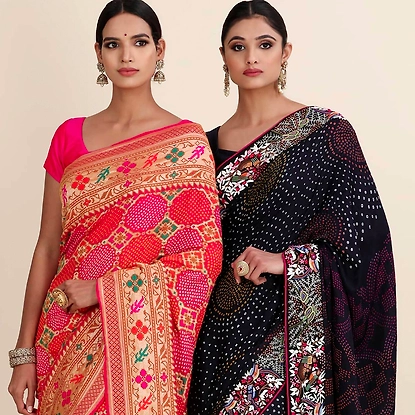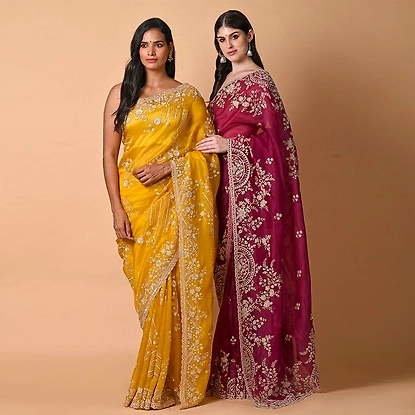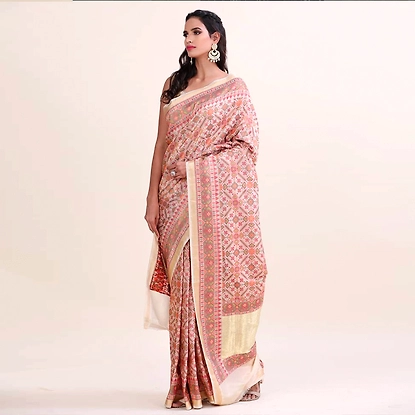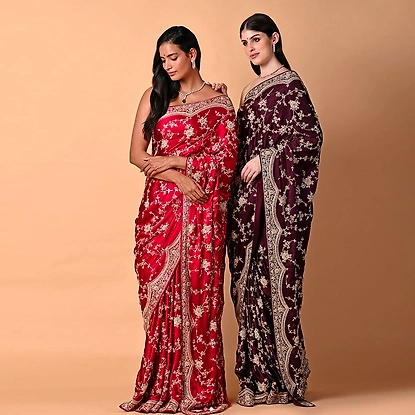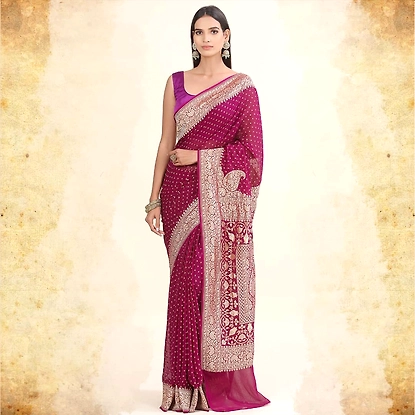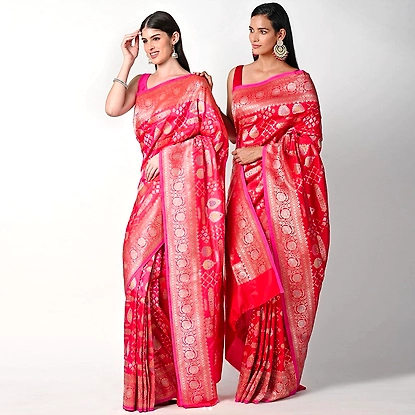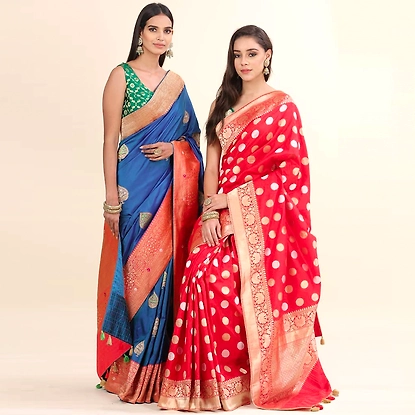Embroidered & Woven Pure Silk, Pure Georgette, Pure Satin Sarees
The saree is a garment traditionally worn in India, Sri Lanka, Pakistan, Bangladesh and Nepal. It can be an heirloom passed down through generations, or a purely functional garment worn everyday. It's seen on streets and runways, and has influenced fashion designers across the world.
We have Sarees from across India
- Slik, Cotton, Velvet, Chiffon, Gorgette, Crape, Satin, Organza, Banarsi, Kanjivaram, Chanderi, Bandhej, Patola, Paithni, Kashmiri, ikat, Kota
- Designer Sarees, Partywear Sarees, Embroided Sareess, Pure Silk Saress, Pastel Sarees, Traditional Sarees, Printed Sarees
10 UNT (Unit)
ROOP SAREES
India
In Stock
1234
50072010

BUY DIFFERENT SAREE STYLES & TYPES
There exist various saree styles for women originating from diverse regions across India, with some of the most favored ones being:
Banarasi Silk Saree: Distinguished by gold embroidery, crafted from premium Banarasi silk through intricate handweaving.
Paithani Silk Saree: Typically created by weaving two silk threads together, adorned with oblique square designs on borders and peacock motifs on the pallu.
Kanjeevaram Saree:Renowned for vibrant colors, particularly cherished by brides in South India.
Bandhani Saree:Crafted through a unique tie-and-dye process, deriving its name from the term "Bandhan."
Chanderi Saree: A blend of cotton, silk, and zari, exuding an aura of royalty with its captivating beauty.
Phulkari Saree: Showcasing intricate flower work, made from khadi or cotton fabrics embroidered with floss silk threads.
Gota Patti Sarees: Adorned with extensive metal embroidery, recognized as Gota work.
Chikankari Saree: Showcasing exquisite embroideries, utilizing fabrics embellished with some of the most appealing decoration styles.
SAREES’ POPULARITY & CHARM
The saree, a traditional Indian garment, continues to captivate hearts worldwide, transcending cultural boundaries and evolving with contemporary trends. Its enduring popularity lies in its timeless elegance, versatility, and ability to accentuate the grace of every woman who wears it. From vibrant silk sarees to casual cotton drapes, the diversity of fabrics and designs caters to diverse tastes and occasions. Social media platforms showcase a global resurgence of interest in sarees, with influencers and celebrities embracing this cultural icon. Beyond its aesthetic appeal, the saree symbolizes tradition, femininity, and a connection to heritage, making it a fashion statement that endures through time.
HOW TO CHOOSE RIGHT SAREE:
When selecting a saree, consider the occasion: choose elegant, detailed designs for formal events and simpler, more casual styles for everyday wear. Pick a saree that suits your body type, with lighter fabrics like cotton for everyday comfort and luxurious silks or chiffons for special occasions. Opt for colors that complement the time of the event and enhance your skin tone. Experiment with different prints, patterns, and embroidery to elevate your style. Comfort is essential, so ensure the saree drapes well and is manageable. Keep up with the current fashion while maintaining your personal style.

"Six yards of elegance, charm and grace" can be the simplest description of a saree. Ever wondered how long this garment has been a part of our lives?
DEFINITION OF A SAREE
A Saree, alternatively spelled as Sari, is a garment worn by women in the Indian subcontinent. It consists of approximately six yards of fabric. Worn in conjunction with a blouse or choli, the saree is draped around the waist over a petticoat, with the left end flowing over the head or shoulder. Sarees come in diverse fabrics, colors, designs, and styles.
THE BEAUTY OF INDIAN SAREES
Sarees transcend mere clothing; they serve as a vibrant embodiment of India's opulent heritage, cultural richness, and exquisite craftsmanship. Immerse yourself in the captivating allure of various Indian sarees, ranging from designer and wedding sarees to party-wear sarees. Each saree is a masterpiece, showcasing the enduring elegance and ingenuity inherent in Indian culture. We are committed to bringing you the latest sarees, ensuring that you have access to the pinnacle of saree fashion. Our unwavering dedication to authenticity, quality, and customer satisfaction distinguishes us as your reliable companion. Explore our curated collection and let the enchantment of Indian sarees redefine your style, enabling you to revel in the beauty and tradition encapsulated by these extraordinary garments.

Saree, also known as sari is a traditional attire of Indian women. The name Sari originated from the Sanskrit word ‘Saadi’ which means ‘a strip of cloth’. In sanskrit literature, it is mentioned as Sattika and as Jatakas in buddhist literature.
The journey of sarees began alongside the Indus valley civilization around 2800 BC and we still use the dyes used then namely Indigo, lac, turmeric etc.
A saree is a long piece of cloth in a variety of fabric with many different prints, patterns and colours that is worn around the entire body in a particular way. The length of the saree varies from 6 yards to 9 yards depending on various factors like age, occasion and climate. Sarees are accompanied by parkars/pavada in the bottom and a choli /ravikai/blouse in the top. A saree has been such an integral part of our culture that even today it is a must have in our wardrobe. Saree as such has undergone various changes in terms of production, weaving, type of prints and the way it is worn. We are in an era where stitched readymade sarees are available and yet draping a saree in the traditional way and mastering it is still revered as a skill.
The journey of sarees began alongside the Indus valley civilization around 2800 BC and we still use the dyes used then namely Indigo, lac, turmeric etc. Earliest records of cotton and silk are also found 5000 years ago indicating how well established this culture was. Literary works like Kadambari by Banabhatta and Silapathikaram by Ilangoadigal talk in detail about sarees. This is just an example, there are many literary works that stand as a proof for the wide use of saree by women from time immemorial. Like the saree, the choli or ravikai or blouse has also undergone a variety of changes from the way it is worn and tied. The Dharmasastra and the Natya shastra are said to have had difference of opinion about how the saree is draped in terms of exposing the midriff.
With such rich heritage, the saree has a lot to be revered for its travel through so many centuries withstanding cultural, economic and technical transformations. For an Indian woman, saree is not just another attire but an extension of her personality. Next time you wear a saree, enlive the rich lineage that unfolds as you pleat it. Remember, you are wearing a piece of garment that has lived through centuries!
